미국 문학 개관 Cold Mountain
 등록일 / 수정일
등록일 / 수정일 페이지 / 형식
페이지 / 형식 자료평가
자료평가 구매가격
구매가격
- 2015.06.27 / 2015.06.27
- 21페이지 /
 hwp (아래아한글2002)
hwp (아래아한글2002) - 평가한 분이 없습니다. (구매금액의 3%지급)
- 1,000원
최대 20페이지까지 미리보기 서비스를 제공합니다.
자료평가하면 구매금액의 3%지급!
 1
1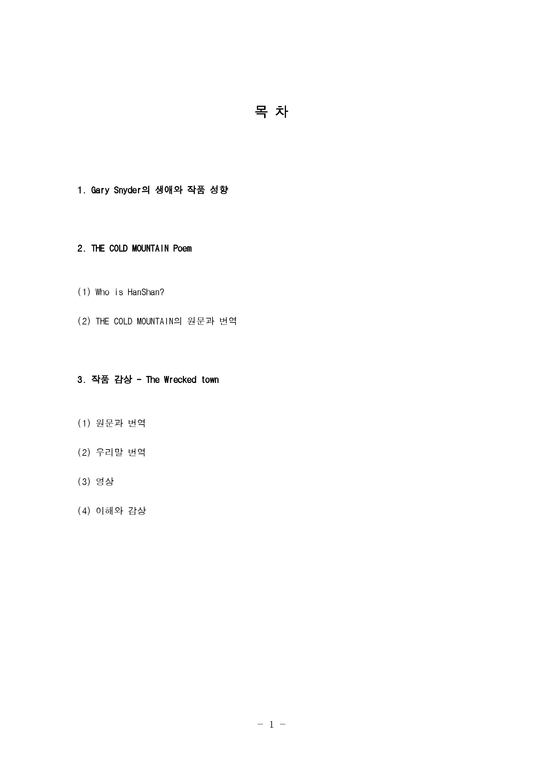 2
2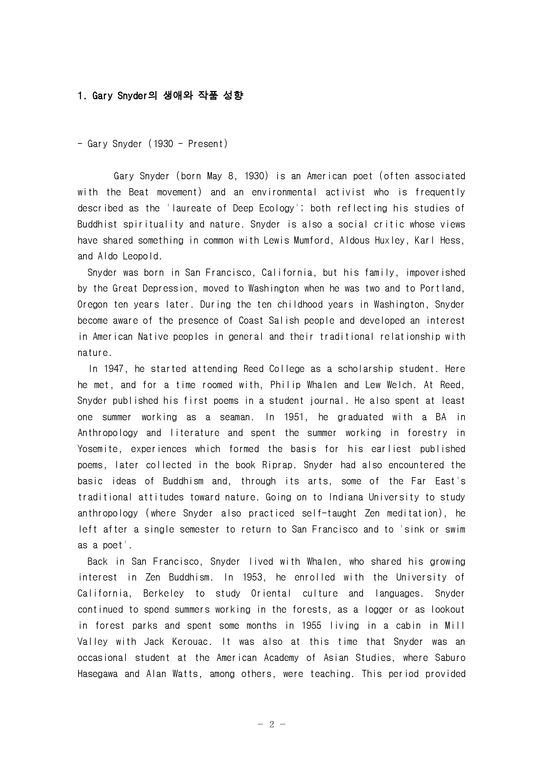 3
3 4
4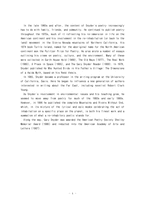 5
5 6
6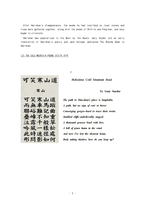 7
7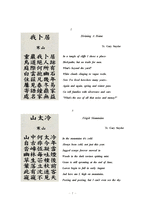 8
8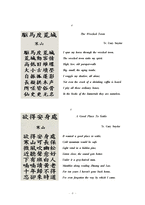 9
9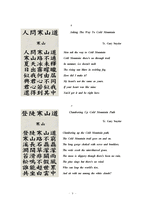 10
10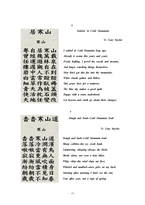 11
11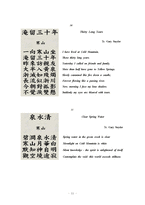 12
12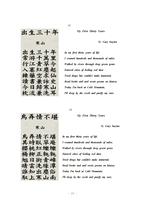 13
13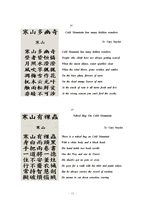 14
14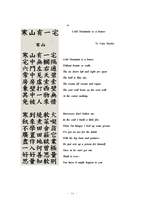 15
15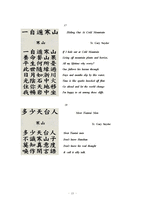 16
16 17
17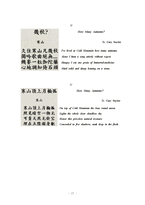 18
18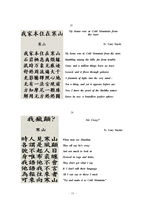 19
19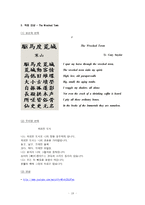 20
20- 본문내용
-
Gary Snyder (born May 8, 1930) is an American poet (often associated with the Beat movement) and an environmental activist who is frequently described as the laureate of Deep Ecology; both reflecting his studies of Buddhist spirituality and nature. Snyder is also a social critic whose views have shared something in common with Lewis Mumford, Aldous Huxley, Karl Hess, and Aldo Leopold.
Snyder was born in San Francisco, California, but his family, impoverished by the Great Depression, moved to Washington when he was two and to Portland, Oregon ten years later. During the ten childhood years in Washington, Snyder become aware of the presence of Coast Salish people and developed an interest in American Native peoples in general and their traditional relationship with nature.
In 1947, he started attending Reed College as a scholarship student. Here he met, and for a time roomed with, Philip Whalen and Lew Welch. At Reed, Snyder published his first poems in a student journal. He also spent at least one summer working as a seaman. In 1951, he graduated with a BA in Anthropology and literature and spent the summer working in forestry in Yosemite, experiences which formed the basis for his earliest published poems, later collected in the book Riprap. Snyder had also encountered the basic ideas of Buddhism and, through its arts, some of the Far Easts traditional attitudes toward nature. Going on to Indiana University to study anthropology (where Snyder also practiced self-taught Zen meditation), he left after a single semester to return to San Francisco and to sink or swim as a poet.
Back in San Francisco, Snyder lived with Whalen, who shared his growing interest in Zen Buddhism. In 1953, he enrolled with the University of California, Berkeley to study Oriental culture and languages. Snyder continued to spend summers working in the forests, as a logger or as lookout in forest parks and spent some months in 1955 living in a cabin in Mill Valley with Jack Kerouac. It was also at this time that Snyder was an occasional student at the American Academy of Asian Studies, where Saburo Hasegawa and Alan Watts, among others, were teaching. This period provided the materials for Kerouacs novel The Dharma Bums. As the large majority of people in the Beat movement had urban backgrounds, writers like Allen Ginsberg and Kerouac found Snyder, with his backcountry and manual-labor experience and interest in things rural, a refreshing and almost exotic individual. Lawrence Ferlinghetti later referred to Snyder as the Thoreau of the Beat Generation.
That same year, after Snyder met with Ginsberg, the latter having sought Snyder out on the recommendation of Kenneth Rexroth, Snyder performed at the famous poetry reading at the Six Gallery in San Francisco (October 13, 1955) that heralded what was to become known as the San Francisco Renaissance. This also marked Snyders first involvement with the Beats, although he was not a member of the original New York circle, but rather entered the scene through an association with Kenneth Rexroth. As recounted in Kerouacs Dharma Bums, even at age 25 Snyder felt he could have a role in the fateful future meeting of West and East. Snyders first book, Riprap, which drew on his experiences as a forest lookout and on the trail crews in Yosemite, was published in 1959.
Independently, a number of the Beats such as Philip Whalen had become interested in Zen, but Snyder was one of the more serious scholars of the subject among them. He, in fact, became a trainee, spending most of the period between 1956 and 1968 in Japan studying Zen first at Shokoku-ji and later in the Daitoku-ji monastery in Kyoto. His previous study of written Chinese assisted his immersion in the Zen tradition (with its roots in Tang Dynasty China) and enabled him to take on certain professional projects while he was living in Japan. Eventually, he decided not to become a monk and to return to the United States to turn the wheel of the dharma.
During this time, he published Myths & Texts (1960) and Six Sections from Mountains and Rivers Without End (1965). (This last was the beginning of a project that he was to continue working on until the late 1990s.) Much of Snyder’s poetry expresses experiences, environments, and insights involved with the work he has done for a living - logging, fire lookout, steam-freighter laboring, translation of texts, carpentry, and life on-the-road presenting his poetry.
Ever the participant-observer, during his years in Japan Snyder not only immersed himself in Zen practice in monasteries but also was initiated into Shugendo, a form of ancient Japanese animism. (See also Yamabushi.) As well, in the early 60s he travelled for some months through India.
In the late 1960s and after, the content of Snyders poetry increasingly has to do with family, friends, and community. He continued to publish poetry throughout the 1970s, much of it reflecting his re-immersion in life on the American continent and his involv
자료평가
-
아직 평가한 내용이 없습니다.
오늘 본 자료
더보기

최근 판매 자료
- [병자호란] 병자호란에 관하여(배경, 전개, 결과 등)A+
- 한국의 교육적 상황에의 부르디외의 논의의 적용
- 맥아더-베이츠 의사소통발달 평가(K M-B CDI)
- [영국시] 셰이머스 히니(Seamus Heaney)
- 조선시대에 실시되었던 비황제도를 설명하고 현 시대에 구황제도와 같은 역할을 하고 있는 제도를 설명하고, 설명한 제도가 더 좋은 방향으로 나갈 수 있도록 예를 들어 설명하시오
- 가치 갈등 해결 수업 모형 - 도덕과 교수_학습 방법 - 4 너희가 있어 행복해 - 3 우리 함께 지켜요
- 삼국시대의 구제사업과 고려시대의 진휼사업, 우리나라의 공공부조 법을 자세히 설명하고 삼국시대와 고려시대의 사업과 현재 우리나라에서 시행되고 있는 공공부조 법 중에서 비슷한 선택하여 현재 우리나라의 공공부조 법이 더 좋아질 수 있는 방법을 예를 들어 서술하시오
- 만1세 연령별 발달특성 알려드려요.(영아 발달평가/관찰일지 작성하실 때 유용)
- 윤동주 자서전 쓰기
- 한국어 어순 결정의 원리
저작권 관련 사항 정보 및 게시물 내용의 진실성에 대하여 레포트샵은 보증하지 아니하며, 해당 정보 및 게시물의 저작권과 기타 법적 책임은 자료 등록자에게 있습니다. 위 정보 및 게시물 내용의 불법적 이용, 무단 전재·배포는 금지됩니다. 저작권침해, 명예훼손 등 분쟁요소 발견시 고객센터에 신고해 주시기 바랍니다.









